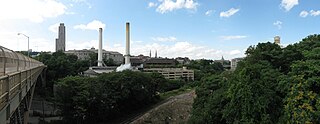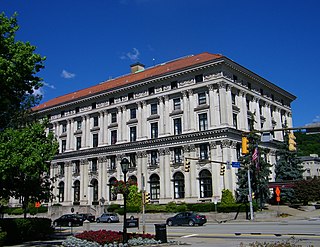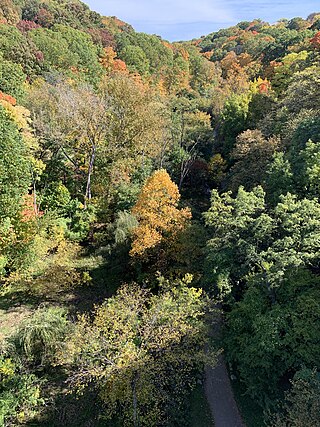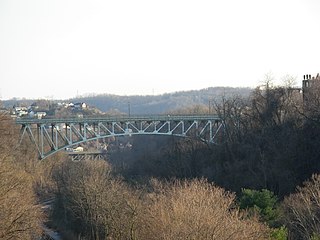
Oakland is the academic and healthcare center of Pittsburgh and one of the city's major cultural centers. Home to three universities, museums, hospitals, shopping venues, restaurants, and recreational activities, this section of the city also includes two city-designated historic districts: the mostly residential Schenley Farms Historic District and the predominantly institutional Oakland Civic Center Historic District, as well as the locally-designated Oakland Square Historic District.

Schenley Park is a large municipal park in Pittsburgh, Pennsylvania, United States. It is located between the neighborhoods of Oakland, Greenfield, and Squirrel Hill. It is also listed on the National Register of Historic Places as a historic district. In 2011, the park was named one of "America's Coolest City Parks" by Travel + Leisure.

The William Pitt Union, which was built in 1898 as the Hotel Schenley, is the student union building of the University of Pittsburgh main campus, and is a Pennsylvania and Pittsburgh History and Landmarks Foundation Historic Landmark.

The Boulevard of the Allies is a mostly four-lane road in the U.S. state of Pennsylvania, connecting Downtown Pittsburgh with the Oakland neighborhood of the city. Because of its lengthy name, locals sometimes refer to it as simply "The Boulevard".

Schenley Plaza is a public park serving as the grand entrance into Schenley Park in Pittsburgh, Pennsylvania.

Panther Hollow is a small, somewhat isolated neighborhood at the bottom of Joncaire Street in Junction Hollow that runs along Boundary Street and is located in the Central Oakland section of Pittsburgh, Pennsylvania. The neighborhood was settled in late 19th century mostly by Italian immigrants from Pizzoferrato and Gamberale, Italy. Even today, park benches and picnic tables in the neighborhood are painted in the red, white, and green of the Italian flag and a sign post marks the distance to the two Italian cities from which most of the original residents arrived. Among its most famous such residents was Pittsburgh boxing legend Mose Butch. A remembrance memorial in the neighborhood, dedicated on December 2, 2007, commemorates the original 95 families that first settled in the neighborhood.

Junction Hollow is a small wooded valley bordering the west flanks of Schenley Park and the campus of Carnegie Mellon University and the southern edge of the University of Pittsburgh's campus in Pittsburgh, Pennsylvania.

Schenley Tunnel is a railroad tunnel in Pittsburgh, Pennsylvania, United States. The tunnel runs beneath Neville Street in the city's North Oakland neighborhood; the south portal is at the upper end of Junction Hollow emerging from under Filmore St., the north emerges from under Centre Ave. into a ravine that opens into Skunk Hollow, between North Oakland and Bloomfield.

The Panther Hollow Bridge is an American steel, three-hinged, deck arch bridge that carries Panther Hollow Road over Panther Hollow in Schenley Park in Pittsburgh, Pennsylvania.

The Pittsburgh Athletic Association was a private social club and athletic club in Pittsburgh, Pennsylvania, USA. Its clubhouse is listed on the National Register of Historic Places.

A panther is the animal that serves as the official mascot of the University of Pittsburgh and used as a nickname for both athletic teams as well as other organizations and affiliates of the university. The mascot is generally referred to as the Pittsburgh Panther or Pitt Panther, while the costumed panther mascot is also named "Roc". Up to 20 physical representations of panthers can be found in and around the university's campus and athletic facilities.

Forbes Avenue is one of the longest streets in Pittsburgh, Pennsylvania, United States. It runs along an east–west route for a length of approximately 7 mi (11 km).

The Schenley Park Casino was Pittsburgh’s first multi-purpose arena. The facility was considered the envy of the sports and entertainment world during the early 1890s, with amenities that were unsurpassed anywhere on the globe. It was built at the entrance to Schenley Park in Oakland near the Phipps Conservatory, the Schenley Bridge and the Carnegie Library of Pittsburgh. The University of Pittsburgh’s Frick Fine Arts Building currently sits on the site of the casino. The casino was the first place in Pittsburgh where organized ice hockey was played. The arena's artificial ice surface was the first of its kind in North America.
The Pittsburgh Athletic Club (PAC) was one of the earliest professional ice hockey teams. It was based in Pittsburgh, Pennsylvania from around 1895 until 1905 and again from 1907 to 1909.
Frank S. Curto was the chief horticulturist for the Pittsburgh Department of Parks and Recreation.

JohnMoore Van Cleve was an American football player and coach. He became one of the earliest known people paid to play the sport when he, Ollie Rafferty, and Peter Wright signed contracts with the Allegheny Athletic Association for $50 per game for the entire 1893 season. Only Pudge Heffelfinger and Sport Donnelly are known to have been professionals earlier.

Panther Hollow is a wooded valley in Pittsburgh, Pennsylvania, that runs approximately 1.5 mi (2.4 km) west to east through Schenley Park. It begins at Boundary Street in Junction Hollow and ends near Hobart Street in Squirrel Hill. Curiously, the neighborhood of Panther Hollow in Central Oakland is not actually in the valley of Panther Hollow itself, but rather in Junction Hollow.

Panther Hollow Lake is a human-made lake in Schenley Park in Pittsburgh, Pennsylvania.

The Greenfield Bridge, officially known as the Beechwood Boulevard (Greenfield) Bridge II, is a steel arch bridge located in Pittsburgh, Pennsylvania, United States. The bridge connects the neighborhoods of Greenfield and Squirrel Hill across the valley known as Four Mile Run which separates them. The bridge also spans the Parkway East (I-376), which runs along the bottom of the valley.

The Charles Anderson Memorial Bridge is a steel deck truss bridge located in Pittsburgh, Pennsylvania, United States. The bridge carries the four-lane roadway of Boulevard of the Allies across a ravine known as Junction Hollow, connecting the neighborhoods of Central Oakland and South Oakland with Schenley Park. The bridge also spans the Junction Hollow Trail and P&W Subdivision railroad tracks which run along the bottom of the valley.























